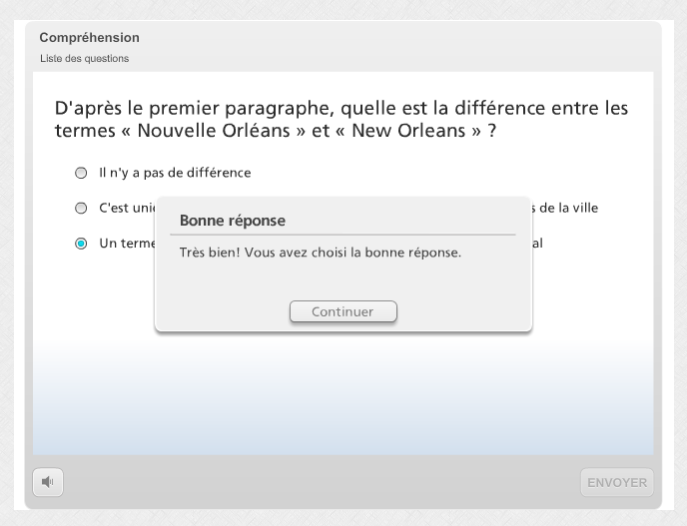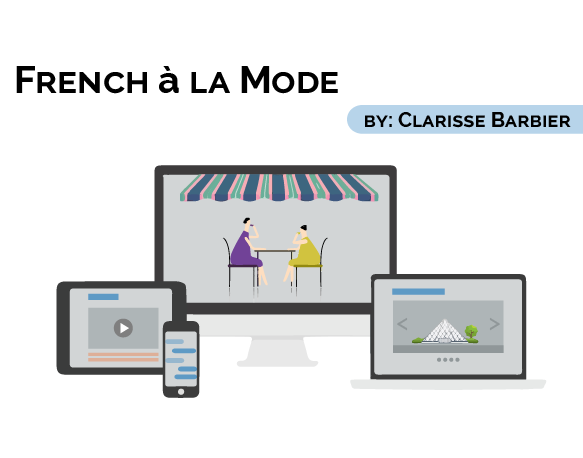Fashionable Language Learning With French à La Mode
 By Clarisse Barbier, French Graduate Student and Teaching Assistant, French and Italian department, University of Kansas, KS.
By Clarisse Barbier, French Graduate Student and Teaching Assistant, French and Italian department, University of Kansas, KS.
During the fall semester 2015, the University of Kansas launched a brand new School of Languages, Literatures and Cultures, federating departments for a stronger unity within the College of Liberal Arts and Sciences. During the convocation celebrating this new unit, the ideas of knowledge-sharing and cultural awareness were emphasized, underlining the value of online resources to promote language learning. Being a graduate student in the French and Italian department, I was glad to be able to contribute to the Open Educational Resources movement.
EXISTING RESOURCES
I have been teaching at KU for the French department for over two years now. The department advocates an immersive teaching method, by using about 90% French starting the first-semester. In the past, students have often asked me for more listening activities with textual help. This is because, although they know how to spell certain words, they don’t always know what they sound like and therefore don’t always recognize them when hearing them. We do offer resources such as the e-book that comes with the online homework product “My French Lab”, the online platform we use at KU. In this e-text, you can click on all target vocabulary items and hear their pronunciation. While the e-text resource is useful in itself for discrete item pronunciation, it shows its limitations when students want to learn how to use a word in context or in the flow of ongoing speech. In the past, I have also often suggested students listen to audio books, though these books do not necessarily use the vocabulary they are studying for their exams. I was a bit frustrated with the lack of adequate useful resources for this type of listening practice, targeted towards typical beginning- and intermediate-level topics. The summer 2015 was the time to seize the opportunity to respond to my students’ requests by working on “French à la mode” (URL: http://french.ku.edu/), a website created by the French Department at the University of Kansas.

The website was initiated by Associate Professor of French, Dr. Kimberly Swanson in collaboration with Dr. Jeff Kendrick, a former Language Coordinator. The website, built at KU by web designer Keah Cunningham, has been developed around typical first/second-year topics, and specifically from the textbooks Chez nous (ed. Pearson) for Elementary French and Intrigue (ed. Pearson) for Intermediate level. The original idea was to build modules around videos from a 90s-2000s French mini-series called Un gars, Une Fille, which started the career of Oscar-winner Jean Dujardin. The TV show sketches were used to provide authentic input on typical situations that can match well to beginning/intermediate-level themes. Originally each module first displayed warm-up questions to get the students to start thinking about the topic on a more individual level. The students are asked to read the questions beforehand to ease up the discussion in class. Then, they complete auto-graded questions about articles from external websites, and finally, they watch the Un Gars Une Fille videos with comprehension and discussion questions.
While the French à la mode site as it existed provided authentic materials for practice, students specifically requested additional activities to help them improve sound-spelling correspondence.
Listening to a language, and more precisely listening to a continuous speech based on vocabulary students may need to know, is an important part of learning a foreign language. The more immersed you are in a language, the more your brain will pick up input. We tend to distinguish native language from foreign language acquisition but they’re more similar a process than we usually think. Babies are constantly surrounded by their native language and their brains draw data from what they hear, progressively weaving the fabric of their native language. A main difference between a native language and a foreign language learned as an adult is that adults are conscious of their effort; unlike babies, adult learners are not allowed to daydream in a crib while their classroom instructor is speaking! Joke aside; listening is, as we all know, a most important part of language skill building, not only for the linguistic knowledge such as syntax, grammar, or pronunciation, but also for sociolinguistic competency and knowing how to use a word properly based on the context.
UPDATING FRENCH A LA MODE
Last summer, I worked as a content developer for EGARC, a language lab at the University of Kansas. I collaborated with Dr. Swanson to develop additional listening activities that would be beneficial not only to our students at KU, but to other independent learners who wish to use the website. We created two types of audio-texts in each module: the first one is a cultural audio-text and the second is a dialogue, both based on the theme of the module and using vocabulary items from the textbooks used by KU students. Although based on themes and vocabulary from specific textbooks, we designed these texts and the activities keeping other users in mind. Indeed, since the module themes are very broad, they can be of use to any learners of French. The text is hidden by default but users have the option to display it.

The cultural texts, “Un peu de culture” were created with comprehension questions in a computer-based quiz, so users can test their understanding of the text. The purpose of the dialogues “Conversation” was to present authentic input. They are medium-paced, casual conversations, performed by myself and another native speaker. We created a worksheet, giving instructors the freedom to use it as a homework assignment or a classroom activity. The dialogue activities were designed to test both linguistic knowledge, such as understanding of lexicon, but also sociolinguistics competency testing students’ recognition of colloquialisms, slang, and structural changes. For instance, Canadian French has similar words as France French, but their meaning is different.
To add to the cultural information in each module, I updated or created the sections on slang and colloquial expressions. The slang section is based on the theme of the module, presenting users with up-to-date, current slang and expressions you can hear if you go to francophone areas or if you watch contemporary videos – so learners will be able to survive the urban Francophone jungle when traveling!
Related to a need for colloquial competencies, I added videos beyond the Un gars, Une fille clips, in order to add more current content and add to the authenticity of the site. Among others, I chose several videos made by French Youtubers who are very popular in France and who are becoming famous internationally. Users can watch them with the option of turning on/off subtitles created and uploaded through the free online editor Amara (URL: https.amara.org). I discovered this tool a year ago and have used it ever since for my own classes. Amara can definitely be used in language classes, and it can also benefit students who have a hearing-impairment or another learning challenge. I am very fond of Amara for its hosting of community-based data, where users can create subtitles from scratch or build upon incomplete or incorrect subtitles for videos – so far only videos from Youtube can be uploaded.
IDEAS TO IMPLEMENT FRENCH A LA MODE IN THE CLASSROOM
These videos and listening activities can be used as part of a whole lesson, following the module organization: warm-up questions; comprehension tasks; pre- and post-viewing activities. They can also be used as stand-alone activities. The reason why they can be treated differently is because we kept in mind the two distinct potential users of the website: instructors and students from KU, and self-directed learners. I personally like to use the videos as a funny introduction to the theme of the lesson so students can hear casual French, often using expressions they are learning in class. The humorous dimension of the videos makes the students more able to relate to French speech and more aware of French as a living language. Students may become more involved and thus prone to participate as well as to remember expressions. I usually use the listening tracks the day before a listening exam as practice. I personally encourage my students to use the tracks to prepare for this portion of the exam, but I do like to have them work on the comprehension questions of the cultural text in class, for several reasons. The cultural text, as previously mentioned, has questions that are computer-graded. Though I may tell my students to work on it on their own, since it is auto graded, I usually project the screen showing the list of questions so students can see what questions to expect while listening to the track a couple times. These questions can also be made available to teachers in Word or PDF format, for use in classes. Then, I divide my students into teams of two or three and display a question. I give them a few seconds before they write down their answer on a paper sheet. I then mark their answers on the board and give them immediate feedback. Students also get immediate feedback from the computer when I show them the right answer.

The visual response from the computer makes learning and practicing for a test look like a game. Many studies have confirmed the value of games in learning/teaching (Sykes & Rheinhardt, 2013), and more and more educators advocate for the use of gaming strategies in the classroom or as homework (visit Education World for more on this topic). As a matter of fact, learners are more engaged and associate the pleasure of playing to learning, and we all know that when we enjoy doing something, it doesn’t feel like work. I have noticed my students are very engaged in playing this listening game, and many have expressed that the listening activities from the website, in class and by themselves, helped them improve their understanding of French.
Another benefit of the use of gamified listening activities I noticed in my classrooms was a greater bond among students. Since they worked in teams to score as much as possible, the emulation of the challenge enabled them to share a fun and competitive moment. After several semesters, I cannot emphasize the importance of good class cohesion, especially in a language class. It is a truism to say that confidence when speaking a different language in front of other people is a major aspect of the foreign language classroom. Public speaking situations can be nerve-wracking, whether it be in business class to present a project, or a thesis defense, but speaking in a foreign language is a particularly sensitive matter. Indeed, when starting to learn a new language as an adult, there is ultimately a feeling of frustration even for the most motivated students, a frustration regarding the discrepancy between one’s native language level of linguistic complexity and one’s foreign language. Some students can eventually shut down in the face of this challenge, even if some level of frustration is often part of any learning experience.
Coincidentally, while working on French à la mode, I found myself learning a bit of a new language: HTML. I realized how it feels to learn a new syntax all over, and I rediscovered the joy of producing “foreign” syntax correctly after trying hard. This experience as a content developer definitely helped strengthened my teaching approach and my own classroom’s management, as, to me, instructors should always be reminded of what it was like to be a student themselves.
This website has been created to foster the spirit of open educational resources and hopefully it will inspire independent learners but also instructors to use it or implement similar approaches in their curriculum. There are so many valuable technological tools out there and more yet-to-be invented, bringing an infinite potential for creativity and improvement of material such as this website. I would be more than happy to hear about your experience with it or other resources you use! The more, the merrier – and most importantly, the better!
REFERENCES
Julie M. Sykes & Jonathon Rheinardt, Language at Play: Digital Games in Second and Foreign Language Teaching and Learning. (New York: Pearson, 2013).

